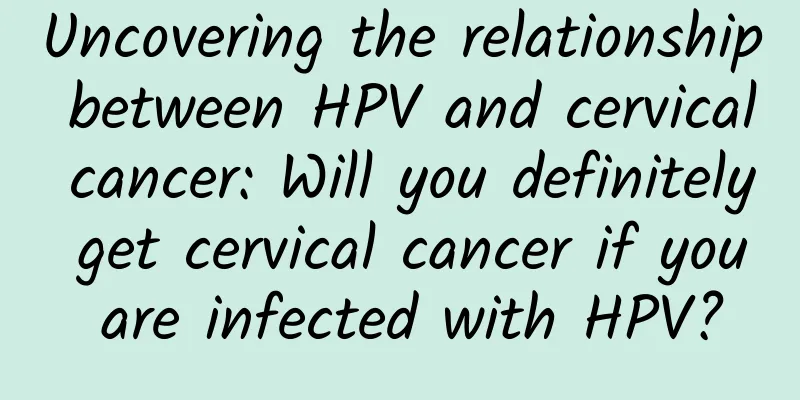Uncovering the relationship between HPV and cervical cancer: Will you definitely get cervical cancer if you are infected with HPV?

|
In the past two years, cervical cancer has been mentioned more and more frequently, which means that many people have heard of it but do not actually understand this disease. Some people even have some misunderstandings about cervical cancer based on hearsay, thinking that as long as they are infected with HPV, they will get cervical cancer. Is this really the case? Actually, this is not the case. There are many causes of cervical cancer, and HPV infection is only one of the most important causes, but not the only one. In addition, even if you are infected with HPV, it does not mean that you will definitely get cervical cancer . In fact, HPV infection is very common in the general population, with the infection rate among normal women ranging from 20-46%[1]. Only a small number of people develop malignant tumors, and for most people, the infection disappears within 2 years[2]. This is because our bodies have their own immune system. Of course, in those few people, the development from HPV infection to cervical cancer is not a one-time process, but a gradual evolution process, which generally takes 10-25 years. This stage is usually called the precancerous lesion stage, or cervical atypical hyperplasia. If precancerous lesions can be detected and treated early, and the potential risk of progression to cervical cancer can be blocked, the occurrence of cervical cancer can be effectively prevented and controlled . Generally speaking, early identification, treatment, and follow-up of cervical precancerous lesions through cervical cancer cell testing (TCT) can significantly reduce the incidence of invasive cervical cancer. Detecting the load of HPV in the body is conducive to the screening of cervical precancerous lesions and follow-up after treatment [3]. Of course, if you are unlucky, it is possible that it will develop into cervical cancer. The symptoms of cervical cancer are mainly manifested in three aspects: vaginal bleeding, vaginal discharge and late symptoms [4]. Vaginal bleeding often manifests as contact bleeding, that is, vaginal bleeding after sexual intercourse or gynecological examination. It can also manifest as irregular vaginal bleeding, or prolonged menstruation and increased menstrual flow. Elderly patients often have irregular vaginal bleeding after menopause. The amount of bleeding varies depending on the size of the lesion and the invasion of blood vessels in the interstitium. If large blood vessels are eroded, it can cause heavy bleeding. In terms of vaginal discharge , most patients have white or bloody, thin, watery or rice-like, and fishy-smelling vaginal discharge. In the late stage, patients may have a large amount of rice-like or purulent leucorrhea due to necrosis of cancerous tissue and infection. In the late stage , patients will have different secondary symptoms according to the extent of cancer involvement, such as frequent urination, urgency, constipation, lower limb swelling and pain, etc. When the cancer compresses or involves the ureter, it can cause ureteral obstruction, hydronephrosis and uremia; in the late stage, there are symptoms of systemic failure such as anemia and cachexia. I believe that through the above description, everyone has a little knowledge about cervical cancer. If you don't want cervical cancer to happen to you, female friends must do HPV screening regularly. Once you suspect that there is a possibility of lesions, please go to a regular hospital for diagnosis and treatment in time. References: [1] Zhang Donghong, Lin Meishan. Meta-analysis of human papillomavirus infection and genotype characteristics in Chinese cervical lesions. Chinese Journal of General Practice, 2010, 13(12): 1287-1290. [2] Qin Fei, Che Jinlian, Xue Yuanling, et al. Application of MRI in the diagnosis and staging of cervical cancer[J]. Journal of Guangxi Medical University, 2013, 30(2): 258-260. [3] Ma Liangkun. Human papillomavirus (HPV) infection and cervical precancerous lesions[J]. Chinese Community Physician: Medical Specialty, 2010(5):1. [4] Xie Xing, Gou Wenli. Obstetrics and Gynecology, 8th edition, People's Medical Publishing House, 2013, P306. |
<<: What are the dangers of vascular aging?
>>: When your skin itches, do you just scratch it?
Recommend
What are the causes of bleeding in women's urine?
Hematuria is something that many people often see...
What kind of tea should women drink to maintain health?
With the development of economy and the improveme...
Echo area of 79 after medical abortion
After medical abortion, in addition to timely con...
Can I have a painless abortion and then insert the IUD directly?
Under normal circumstances, if the painless abort...
What are the symptoms of abnormal thyroid function in pregnant women?
Abnormal thyroid function is generally prevalent ...
Can gallbladder polyps be eliminated through exercise? Which exercises are better?
Gallbladder polyps usually cannot be eliminated t...
Tissue discharge on the seventh day after medical abortion
Compared with surgical abortion, medical abortion...
What is the cause of the brown discharge?
In daily life, many women have the problem of bro...
What should pregnant women do if they have acute
Genital warts are a sexually transmitted disease ...
What should I do if I have sex five days after an abortion?
There is a long recovery period after an artifici...
What should women eat if they are calcium deficient?
Calcium is an important element for maintaining o...
How should women solve insomnia during menopause?
Menopause is a topic that female friends are relu...
How to prevent cervicitis?
Women are very afraid of suffering from gynecolog...
What should you pay attention to when you have your first menstrual period? It turns out to be these 8 points
A girl's first menstruation is also called me...









